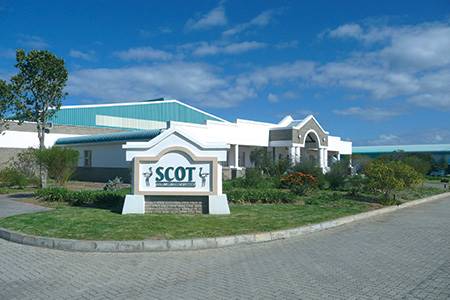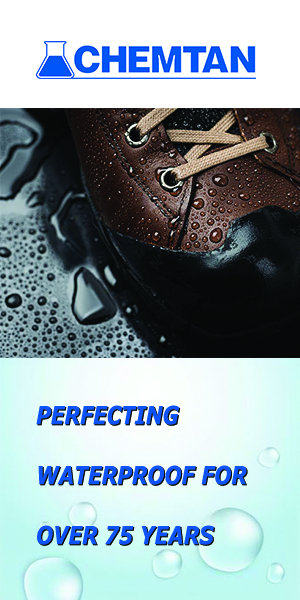South Cape Ostrich Tanning, Mossel Bay, South Africa

South Cape Ostrich Tanning (SCOT), in South Africa, is a young business, as things go in the leather industry, only ten years old. Its founders started to put the necessary machinery and facilities in place at the end of 1999 and produced their first tanned ostrich skin in March 2000. That skin, with the signatures of the key people involved at the time, is now on display at the entrance to the building. Today, SCOT employs 86 people and has the capacity to produce 75,000 finished skins a year. There are around 240 colour options and 28 finishes are available at the moment, although 80% of finished output is black. Its main markets are high-end fashion houses, many of whom value ostrich leather highly as one of the materials they use for handbags and small leathergoods, and manufacturers of western-style cowboy boots in Mexico and the US.
Ostrich leather, with its distinctive quill marks where the bird’s feathers used to be, is exotic, beautiful and in demand. SCOT, one of a small number of tanneries in South Africa that specialises in the material, takes a simple approach and makes aniline leather from the skins, priding itself on the quality of its product at the crust, dyed crust and finished leather stages.According to marketing director, Frik Kriek, the tannery’s exclusive focus on ostrich leather brings three main advantages. It’s an exotic leather, and a fairly well known one. It requires no certification from CITES because the birds are bred quite extensively. Their meat is popular, especially in Europe, and even their feathers have a value in the world of fashion. Secondly, it’s well accepted that South Africa is the source of the best quality ostrich leather in the world, meaning that any South African tannery choosing to work with this material will have easier access to the best skins. And, lastly, ostrich leather is what he calls a value multiplier.
“What I mean by that,” he explains, “is that it carries value in itself. The image ostrich leather projects of any fashion house offering it is a positive one. It’s like crocodile in that regard, but without wishing to show any lack of respect to crocodile leather tanners, ostrich has no question marks hanging over it with regard to green issues. People are eating the meat quite widely now.”
One disadvantage he points to is the transparency of the ostrich industry. The tannery pays ostrich farmers in the local currency, the rand. If the rand is weak, customers know that the tannery would stand to gain by earning more from an unchanged sales price in euros or dollars and want some of the benefits passed on to them right away. “This has been agony in the last couple of years,” Mr Kriek says. “Currency fluctuations cause instability and it’s very frustrating.”
There is another source of frustration. The tannery is just along the coast from the most southerly point on the African continent and sometimes feels, Mr Kriek continues, isolated and cut off from regular personal contact with customers. SCOT has representatives around the world whom it relies on to push the leather along the distribution channels. The difficulty is that ostrich is usually just one component of a range of exotic leathers that these partner companies offer to clients, with other types, notably crocodile, probably proving easier to push in recent years.
“Crocodile was flying out of the door,” he says, “and demand for ostrich leather seemed lower than it should have been. It came home to us that there are disadvantages for us in not always being customer-facing and forced us to ask how much value the distribution channel is adding to our product today. So we are considering a change of strategy here. We don’t want to cut any of our existing partners out; we’d just like them to push a bit more.”
The physical distance from the South Cape to, say, Paris is not the issue here. If the leather is in stock, SCOT can land an order anywhere in the world within “three to four days”. “If the customer gets the money to us and we have the stock, we can do it,” the marketing director explains. “Logistically, we are not that far away. Recently I got a call from a customer in Hong Kong at nine o’clock on a Friday morning. He said he needed the leather by eleven o’clock, Hong Kong time, on Monday morning. Well, we had the stock and we did it. The customer called later to say he hadn’t believed me when I said we’d do it.”
Relationship with production
One of the factors that allowed that Hong Kong customer in the previous example to receive his order is the close relationship between the marketing team and the production team at SCOT. Production director, Pieter Yzelle, is one of the founders of the tannery and has travelled extensively over the last ten years to industry exhibitions and to visit customers. Frik Kriek believes this gives impetus to the customer relationships he is working hard to strengthen. He acknowledges that there must be a bridge between marketing and production in any successful company, but insists that SCOT aims to eliminate any gap that might exist. “I try to make sure my technical colleagues—Pieter, his son Johan, who is in charge of the wet end, and Cobus Brink, who is in charge of finishing—are not in a backroom, and I think the lack of walls between us is a reason for our success,” he says.
Pieter Yzelle took responsibility for setting up the tannery’s work-flows and production systems. He says that one of the biggest decisions he had to take concerned achieving the right balance between handling and automation, between people and machines. Much thought went into this, ranging from the number of physical checks each skin receives by human eye and hand finished on the way to the crust stage (the answer is ten), to the specific demands on machinery imposed by the size of an ostrich skin, around 1.5 square-metres (the tanning drums were made specially for SCOT by Vallero, with dimensions of 2.7 metres in diameter and 2.5 metres in length).
He explains: “You do need to automate some aspects, such as water control, for example; you could never achieve the quantities and temperatures the system needs by turning one tap or another. But we are in the business of making aniline leather and we would like it to look as natural as possible, with as little finish as possible. We can only achieve this by thinking of leather production in the same light as making wine or cheese. I feel strongly about this. Yes, you need the chemistry, but you also need an appreciation of the product; art and love are part of the recipe for success too.”
Future trends
The technical team also takes a keen interest in matters such as trend forecasts, and places special store by the predictions that come from the team at Le Cuir À Paris, who twice a year gives details of the colours and types of leather finish that it believes the big fashion houses will demand in seasons to come. Some of the forecasts that come from leading specialist leather chemical companies also go down well on the South Cape, and the reason for picking these, along with the information from the Paris exhibition, is that in SCOT’s experience, the details are faithful to what the big fashion houses they work with do ask for in time. And if the relationship with the customer is strong enough, as it is in some special cases, there is no need to wait to be asked; the tannery will suggest colours and effects to the customer.
“I would say that 30% of our ostrich leather goes into European fashion houses,” Frik Kriek explains. “This is very important for us because it creates a pull factor. We have a very intensive relationship with Hermès, for example, which uses some ostrich leather every year in its handbag collections. With other companies we don’t experience any consistency: they use ostrich one season and then not for the next four years. We don’t expect them to buy 5,000 skins a year, but it would be good if they would buy, say, 1,000.”
In spite of this, and in spite of the global economic downturn, Mr Kriek is disinclined to spend too much of his time searching for new customers. Some, such as one boot manufacturer, have come to SCOT, rather than the other way round. In other cases, the financial situation of the potential new customers is an unknown, leading the tannery to prefer the devil it knows. “It is a struggle at the moment,” he admits. “It’s a struggle just to meet the sales volume and try to bring in some profit. We think continuing with our existing customers is the best way to do that, even if it is at lower volumes and, yes, at a lower price than before. We have to keep the skins moving. We can’t just buy what we require; we have to take what we are given by the ostrich farmers in the South Cape.”
Company structure
It’s clear from the earlier remarks about the supply of skins that this tannery is part of an unusual set-up. As mentioned, it is run by a professional leather production management team, but it’s mostly owned by a parent company called Mosstrich, whose shareholders are around 180 ostrich farmers across the South Cape region, of whom between 80 and 100 actively supply ostrich skins at the moment.
That’s to say, they supply the birds to the Mosstrich abattoir, earning around $5 per kilo (cold carcass weight) for the meat, and the abattoir passes the skins to SCOT. It helps that the tannery is only 75 metres away; operatives go across to the abattoir once an hour and bring a batch of raw skins back in small hand-pulled wagons.
But the farmers’ interest continues after this changeover. As shareholders of the tanning company, they want it to be successful, but they also have a vested interest in that the tannery adds substantially to the cash in hand they receive for the birds they raise. The leather is worth more than the meat, although the price is more variable because it depends on the market rate and it depends on the size and grade of the skins at crust stage. But one skin can easily be worth hundreds of dollars.
On the plus side, the tannery has to spend little time and energy managing its raw material supply chain, an aspect of the business that makes life difficult for so many leather producers, between fielding calls from traders, struggling to gain insight into what’s going on in the wider market, agonising over the way prices will go and when will be the best time to buy hides. Ostriches hatch in season and are ready for the abattoir 11 or 12 months later, and when they’re ready, they arrive. October to March is the busy time, during which 7,000 skins per month can easily make the short journey from the slaughterhouse to SCOT. This means SCOT could not halt the supply of skins in times of lower demand or higher stock even if it wanted to. Its capacity is to tan only 6,000 skins per month, so its solution for dealing with the fluctuations and the fastest flows is to wet-salt every skin that comes in. They can keep in this state for up to four months, making it easy for the production team to feed them into the tannery’s workflow when the time is right and when demand requires.
Cash in hand
As well as having an obligation to use all of the skins Mosstrich produces, SCOT has a commitment to pay its raw material suppliers as much as possible as quickly as possible. This is the opposite of what happens in most parts of the leather industry and requires further explanation.
As managing director of Mosstrich, François de Wet has responsibility for maintaining good communication between the tannery team and the farmers. “The relationship works,” he insists. “We have been going ten years and the return on investment the farmers have received as shareholders/raw material suppliers of the tannery is good, and if at the end of the year the tannery has done well, the farmers earn a production bonus. I accept that it puts the tannery in an unusual position; it has to serve its raw material suppliers as well as its end customers. What I would say, though, is that we have access here to a limited supply of very high quality raw material, and we have to try to sustain that and protect it because SCOT is not the only tannery the farmers could sell to. That’s why we pay them as much as possible.”
The SCOT-Mosstrich relationship adds another dimension. According to Dr de Wet, it gives the farmers a far-reaching view of what they are producing. We know that many farmers regard the leather that tanneries produce from the hides of their livestock as, at best, an afterthought. All the Mosstrich farmer/shareholders, he explains, have a view of what happens to their live ostriches, and of the added value the birds can bring, all the way from the field to high-class handbags in a Hermès boutique in Paris or Tokyo. “They are conscious of this and, naturally, they try to protect their position,” he adds. “They know that if too much money flowed out of SCOT in the form of shareholders’ dividends, we might end up with no company. And if we have to take a decision to pay shareholders less to protect the company, don’t forget that it’s these same guys who must make that decision, and they do, without any hesitation. But if, at the same time, we ended up with a profit of 100 million rand (around $12.5 million) at the end of the year, it would be an indication that we had mismanaged the relationship because it would mean more money could have been in the hands of the farmers at an earlier stage.”
Everything evens itself out in the end; SCOT cannot, he says, “hide the money” and doesn’t want to. The Mosstrich Board of Directors, mainly farmers, will decide what percentage of any such profit they will divide among themselves, and what percentage to invest back in the operation to fund the purchase of new equipment, for example.
About people
For the last two-and-a-half years, a 6.5% shareholding in SCOT has been in the hands of the Mosstrich Black Economic Empowerment Trust, a body set up by the company to help workers from the Black community, in this case, people working on the shop floor either in the tannery or the abattoir, to benefit directly from business success. Dr de Wet describes the relationship between the management team and all of the workers in the tannery as positive. People are only human and there have been, at times, some quite heated verbal exchanges, but at no stage in the history of the business have workers downed tools, far less gone on strike. It may not always be moonlight and roses, but he insists that the human relationships are strong enough to withstand any differences of opinion that have occurred so far.
In the twenty-first century, it’s impossible to cover the subject of employee-management relations in South Africa without raising the subject of HIV and AIDS. The Mosstrich Group has worked hard to raise awareness of the subject among its workers, emphasising the importance of people knowing their own status. “The workers are hungry to receive correct information in terms of HIV,” the managing director says. “We first did some training on this about five years ago. Two years later, we asked the workforce for their opinions on what we should devote training time and budget to and they asked for a session on HIV again. We’re happy to help in any way we can.”
Turning to more pleasant matters, the company also sponsors a workers’ soccer team, and sponsors student places for disadvantaged young people at a variety of schools around the Southern Cape, and at a specialist agriculture college in the nearby town of Riversdale.
For François de Wet, the most important thing for SCOT to do in the years ahead is to maintain this dynamic, to sustain the relationship for the benefit of the farmers, of the tannery and of the people who work there. “We have other plans,” he adds. “There are new leather finishes that we want to develop to help us make our customers and consumers really excited about ostrich leather. There is only so much we can do, compared to bovine, but we have developed some new ideas in the past year. We also hope to develop the appeal of ostrich leather away from handbags and cowboy boots and move more into clothing. We already have one customer who has put our leather into a collection of jackets and we’re very excited about that.”
Ostrich leather has lost ground in the last five or six years to other exotics, especially crocodile. But crocodile seems to have taken a bigger hit in the economic squeeze and SCOT harbours the hope that they can help re-establish ostrich as the preferred exotic leather. “There are many wealthy people in the world, who, unfortunately, still don’t know what ostrich leather is,” François de Wet says. “The money involved with this material, across the whole of the industry, is too little for us all to launch a collective campaign to promote ostrich leather, so we have a challenge in trying to find a way to boost demand for the leather, but we are working on it.”






























